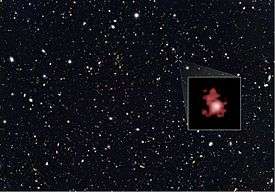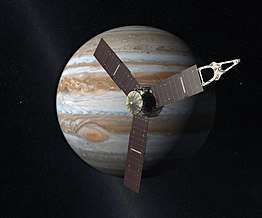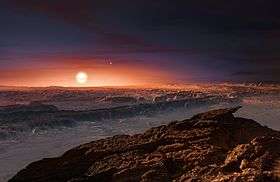HIP 41378
HIP 41378 is a star located 348 light-years away in the constellation of Cancer. The star has an apparent magnitude of 8.92. This F-type main sequence dwarf has a mass of 1.15 M☉ and a radius of 1.25 R☉. It has a surface temperature of about 6,251 K.
| Observation data Epoch J2000 Equinox J2000 | |
|---|---|
| Constellation | Cancer |
| Right ascension | 08h 26m 27.84923s[1] |
| Declination | +10° 04′ 49.3340″[1] |
| Apparent magnitude (V) | 8.92[2] |
| Characteristics | |
| Evolutionary stage | Main sequence[3] |
| Spectral type | F8[4] |
| Astrometry | |
| Radial velocity (Rv) | 50.42[1] km/s |
| Proper motion (μ) | RA: −48.143[1] mas/yr Dec.: 0.059[1] mas/yr |
| Parallax (π) | 9.3799 ± 0.0590[1] mas |
| Distance | 348 ± 2 ly (106.6 ± 0.7 pc) |
| Details | |
| Mass | 1.15+0.06 −0.05[5] M☉ |
| Radius | 1.25+0.16 −0.11[5] R☉ |
| Surface gravity (log g) | 4.28 cgs |
| Temperature | 6,251[5] K |
| Metallicity [Fe/H] | 0.00[5] dex |
| Rotational velocity (v sin i) | 5.7[5] km/s |
| Other designations | |
| Database references | |
| SIMBAD | data |
Planetary system
In 2016, the K2 Kepler mission discovered five planets around HIP 41378, with sizes ranging from 2 times the size of Earth to the size of Jupiter, out to about 1 AU for the outermost planet. The semi-major axes were not known until 2019, when K2 Haute-Provence Observatory radial velocity data has allowed more qualification. Also, a sixth non-transiting planet, HIP 41378 g, was discovered, and additional planets are still suspected between HIP 41378 g and HIP 41378 d.[6] The planet HIP 41378 f was also found to likely have an optically-thick rings or highly extended atmosphere.
| Companion (in order from star) |
Mass | Semimajor axis (AU) |
Orbital period (days) |
Eccentricity | Inclination | Radius |
|---|---|---|---|---|---|---|
| b | 6.89 ± 0.88 M⊕ | 0.1283 | 15.57208 ± 0.00002 | 0.07 ± 0.06 | 88.75 ± 0.13° | 2.17 ± 0.28 R⊕ |
| c | 4.4 ± 1.1 M⊕ | 0.2161 | 31.706038 ± 0.00006 | 0.04 | 88.477 ± 0.06° | 2.727 ± 0.06 R⊕ |
| g | 7.0 ± 1.5 M⊕ | 0.3227 ± 0.0036 | 62.06 ± 0.32 | 0.06 | — | — |
| suspected | — | — | 93-131 | — | — | — |
| d | 2.3 ± 2.3 M⊕ | 0.88 ± 0.01 | 278.3618 ± 0.0005 | 0.06 ± 0.06 | 89.80 ± 0.02° | 3.54 ± 0.06 R⊕ |
| e | 12 ± 5 M⊕ | 1.06 ± 0.03 | 369 ± 10 | 0.14 ± 0.09 | 89.84 ± 0.07° | 4.92 ± 0.09 R⊕ |
| f | 12 ± 3 M⊕ | 1.37 ± 0.02 | 542.07975 ± 0.00014 | 0 | 89.971 ± 0.01° | 9.2 ± 0.1 (radius of rings?) R⊕ |
References
- Brown, A. G. A.; et al. (Gaia collaboration) (August 2018). "Gaia Data Release 2: Summary of the contents and survey properties". Astronomy & Astrophysics. 616. A1. arXiv:1804.09365. Bibcode:2018A&A...616A...1G. doi:10.1051/0004-6361/201833051. Gaia DR2 record for this source at VizieR.
- Høg, E.; Fabricius, C.; Makarov, V. V.; Urban, S.; Corbin, T.; Wycoff, G.; Bastian, U.; Schwekendiek, P.; Wicenec, A. (2000). "The Tycho-2 catalogue of the 2.5 million brightest stars". Astronomy and Astrophysics. 355: L27. Bibcode:2000A&A...355L..27H.
- Santerne, A.; Malavolta, L.; Kosiarek, M. R.; Dai, F.; Dressing, C. D.; Dumusque, X.; Hara, N. C.; Lopez, T. A.; Mortier, A.; Vanderburg, A.; Adibekyan, V.; Armstrong, D. J.; Barrado, D.; Barros, S. C. C.; Bayliss, D.; Berardo, D.; Boisse, I.; Bonomo, A. S.; Bouchy, F.; Brown, D. J. A.; Buchhave, L. A.; Butler, R. P.; Collier Cameron, A.; Cosentino, R.; Crane, J. D.; Crossfield, I. J. M.; Damasso, M.; Deleuil, M. R.; Delgado Mena, E.; et al. (2019). "An extremely low-density and temperate giant exoplanet". arXiv:1911.07355 [astro-ph.EP].
- Hill, Sarah J.; Schilt, Jan (1952). "Photographic magnitudes of 55700 stars in the zones 10 deg to 20 deg and 30 deg to 50 deg". Contributions from the Rutherford Observatory of Columbia University New York. 32: 1. Bibcode:1952CoRut..32....1H.
- Petigura, Erik A.; Crossfield, Ian J. M.; Isaacson, Howard; Beichman, Charles A.; Christiansen, Jessie L.; Dressing, Courtney D.; Fulton, Benjamin J.; Howard, Andrew W.; Kosiarek, Molly R.; Lépine, Sébastien; Schlieder, Joshua E.; Sinukoff, Evan; Yee, Samuel W. (2018). "Planet Candidates from K2 Campaigns 5-8 and Follow-up Optical Spectroscopy". The Astronomical Journal. 155 (1): 21. arXiv:1711.06377. Bibcode:2018AJ....155...21P. doi:10.3847/1538-3881/aa9b83.
- Andrew Vanderburg; et al. (2016). "Five Planets Transiting a Ninth Magnitude Star". The Astrophysical Journal. 827 (1): L10. arXiv:1606.08441v1. Bibcode:2016ApJ...827L..10V. doi:10.3847/2041-8205/827/1/L10.
- exoplanet.eu Planet HIP 41378 g


